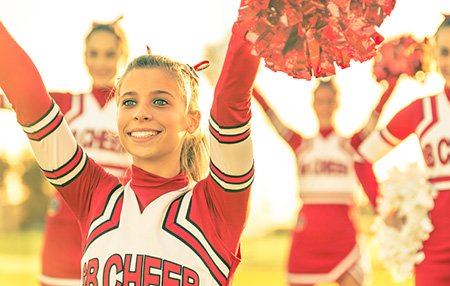Cheerleading Injuries
 The rise of competitive cheering has led to an increased level of difficulty in the sport, along with a higher risk of injuries. Cheerleaders of all skill levels can find the expert care they need at Henry Ford Health.
The rise of competitive cheering has led to an increased level of difficulty in the sport, along with a higher risk of injuries. Cheerleaders of all skill levels can find the expert care they need at Henry Ford Health.
Cheerleading injury causes
The sport of cheerleading has evolved to include more lifts, tosses and explosive tumbling than ever before. From building pyramids to high-flying basket tosses, stunting can lead to a range of traumatic injuries. Falls on hard surfaces or collisions with team members can result in head and neck injuries, as well as fractures in the hands and wrists.
Cheerleading can also be a three- or four-season sport. Without an “off-season” or periods of rest and recovery, cheerleaders are prone to overuse injuries. They can develop musculoskeletal problems in their ankles and knees. Imbalances in muscle strength or weak core strength can lead to back and joint pain.
Common cheerleading injuries we treat
These are just a few of the cheerleading injuries our sports medicine team treats:
- Ankle, knee and wrist sprains
- Anterior cruciate ligament (ACL) injuries
- Concussions and head injuries
- Exertional compartment syndrome (muscles in the arms or legs don’t get enough oxygen during exercise)
- Lower body compression fractures
- Spondylolisthesis (bones of the spine slip out of place)
- Spondylolysis (stress fractures in the spine)
Cheerleading injury treatment
We use a variety of techniques to treat cheerleading injuries, including:
- Injury protection: We may use splints or braces to protect the injured area so you don’t sustain more damage.
- Pain control: We may use ice to reduce inflammation or heat to relax tight muscles. Ultrasound therapy can also ease muscle tension and stimulate healing. Electrical stimulation eases pain by blocking pain signals from your nerves to your brain.
- Low-impact conditioning: We make sure you stay conditioned while you rest and heal. Our anti-gravity treadmill helps you gradually return to exercise, without putting the stress of your full body weight on your joints. We may recommend this treatment for stress fractures in your lower limbs.
- Specialized strength and flexibility training: We help cheerleaders strike the right balance of strength and flexibility. Good core and back strength improve stability, which takes stress off joints and reduces your risk of injuries. We can also use force-plate assessments at our Center for Athletic Medicine to identify and address underworked muscle groups.
If you need surgery for a cheerleading injury, our orthopedic surgeons offer a variety of advanced procedures. Whenever possible, we use minimally invasive techniques. These surgeries have a lower risk of complications and can help you get back to your sport faster and with less pain.
Cheerleading injury prevention
Here are some key ways to reduce your risk of cheerleading injuries:
- Commit to other complementary physical activities, such as strength training, yoga or Pilates. These activities help condition underused muscle groups.
- Follow stunt restriction protocols, including having the required number of spotters and limiting pyramid heights.
- Never attempt new stunts without proper training. Avoid difficult stunts if you’re fatigued, in pain or cheering in poor weather.
- Use protective equipment, such as landing mats, during practice and competition.
Cheerleading injury care: Why choose Henry Ford?
Highlights of our sports medicine program include:
- Collaborative care: Our team includes sports medicine physicians, orthopedic surgeons and certified athletic trainers. We work closely with radiologists, physical therapists and other providers to seamlessly coordinate your care.
- Minimally invasive treatment options: From Tenex procedures to treat Achilles and Patellar tendons to plasma-rich protein (PRP) injections to treat knee injuries there are options available to reduce procedure time, hasten recovery and increase potential for improved outcomes.
- Prompt diagnosis and treatment: Most providers can see you within 24 to 48 hours, so you receive prompt care for your injury. We offer in-person and virtual appointments. We perform a thorough assessment and have on-site imaging so we can get your treatment started as soon as possible.
- Support for student athletes: Henry Ford athletic trainers are on the sidelines at many area schools to provide first aid and help with injury prevention. We work directly with coaches, athletes and parents to keep cheerleaders feeling their best and performing safely.
Explore our blogs
Learn more about sports injuries and injury prevention:
- Preventing Sports Injuries in Your Student Athlete
- The Dangers of Returning to a Sport Too Soon After an Injury
- What to Feed Your Student Athlete Before and After the Game
.svg?iar=0&hash=F6049510E33E4E6D8196C26CCC0A64A4)

/hfh-logo-main--white.svg?iar=0&hash=ED491CBFADFB7670FAE94559C98D7798)